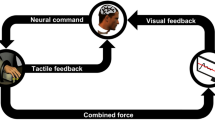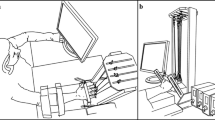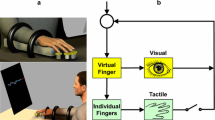Abstract.
We offer a hypothesis on the organization of multi-effector motor synergies and illustrate it with the task of force production with a set of fingers. A physical metaphor, a leaking bucket, is analyzed to demonstrate that an inanimate structure can show apparent error compensation among its elements. A neural model is developed using tunable back-coupling loops as means of assuring error compensation in a task-specific way. The model demonstrates non-trivial features of multi-finger interaction such as delayed emergence of force stabilizing synergies and simultaneous stabilization of the total force and total moment produced by the fingers. The hypothesis suggests that neurophysiological structures involving short-latency feedback may play a central role in the formation of motor synergies.
Similar content being viewed by others
References
JH Abbs VL Gracco (1984) ArticleTitleControl of complex motor gestures: Orofacial muscle responses to load perturbations of the lip during speech J Neurophysiol 51 705–723
MB Berkinblit AG Feldman OI Fukson (1986) ArticleTitleAdaptability of innate motor patterns and motor control mechanisms Behav Brain Sci 9 585–638
F Danion G Schöner ML Latash S Li JP Scholz VM Zatsiorsky (2003) ArticleTitleA force mode hypothesis for finger interaction during multi-finger force production tasks Biol Cybern 88 91–98 Occurrence Handle10.1007/s00422-002-0336-z Occurrence Handle12567224
T Fukai (1999) ArticleTitleSequence generation in arbitrary temporal patterns from theta-nested gamma oscillations: a model of the basal ganglia-thalamo-cortical loops Neural Netw 12 975–987
IM Gelfand ML Latash (1998) ArticleTitleOn the problem of adequate language in motor control Motor Control 2 306–313
Gelfand IM, Tsetlin ML (1966) On mathematical modeling of the mechanisms of the central nervous system. In: IM Gelfand, VS Gurfinkel, SV Fomin, ML Tsetlin (eds) Models of the structural-functional organization of certain biological systems. pp 9–26, Nauka: Moscow (in Russian, a translation is available in 1971 edition by MIT Press, Cambridge)
JN Guzman A Hernandez E Galarraga D Tapia A Laville R Vergara J Aceves J Bargas (2003) ArticleTitleDopaminergic modulation of axon collaterals interconnecting spiny neurons of the rat striatum J Neurosci 23 8931–8940 Occurrence Handle1:CAS:528:DC%2BD3sXotFOnurs%3D Occurrence Handle14523095
H Hultborn RB Brownstone TI Toth JP Gossard (2004) ArticleTitleKey mechanisms for setting the input-output gain across the motoneuron pool Prog Brain Res 143 77–95
YP Ivanenko RE Poppele F Lacquaniti (2004) ArticleTitleFive basic muscle activation patterns account for muscle activity during human locomotion J Physiol 556 267–282
R Katz R Mazzocchio A Penicaud A Rossi (1993) ArticleTitleDistribution of recurrent inhibition in the human upper limb Acta Physiol Scand 149 183–198
JA Kelso B Tuller E Vatikiotis-Bateson CA Fowler (1984) ArticleTitleFunctionally specific articulatory cooperation following jaw perturbations during speech: evidence for coordinative structures J Exp Psychol: Hum Percept Perform 10 812–832
TG Kincaid MA Cohen Y Fang (1996) ArticleTitleDynamics of a winner-take-all neural network Neural Netw 9 1141–1154
ML Latash ZM Li VM Zatsiorsky (1998) ArticleTitleA principle of error compensation studied within a task of force production by a redundant set of fingers Exp Brain Res 122 131–138 Occurrence Handle10.1007/s002210050500 Occurrence Handle1:STN:280:DyaK1cvkslCjtA%3D%3D Occurrence Handle9776511
ML Latash JF Scholz F Danion G Schöner (2001) ArticleTitleStructure of motor variability in marginally redundant multi-finger force production tasks Exp Brain Res 141 153–165 Occurrence Handle10.1007/s002210100861 Occurrence Handle1:STN:280:DC%2BD3MnmslGhug%3D%3D Occurrence Handle11713627
ML Latash JF Scholz F Danion G Schöner (2002a) ArticleTitleFinger coordination during discrete and oscillatory force production tasks Exp Brain Res 146 412–432
ML Latash JP Scholz G Schöner (2002b) ArticleTitleMotor control strategies revealed in the structure of motor variability Exer Sport Sci Rev 30 26–31
ML Latash JK Shim VM Zatsiorsky (2004) ArticleTitleIs there a timing synergy during multi-finger production of quick force pulses? Exp Brain Res 159 65–71
ZM Li ML Latash VM Zatsiorsky (1998) ArticleTitleForce sharing among fingers as a model of the redundancy problem Exp Brain Res 119 276–286 Occurrence Handle10.1007/s002210050343 Occurrence Handle1:STN:280:DyaK1c3htFGmsQ%3D%3D Occurrence Handle9551828
EG Litinov (2002) ArticleTitleLateral inhibition as a possible mechanism for evaluating stimulus intensity Neurosci Behav Physiol 32 231–235
JS Lund A Angelucci PC Bressloff (2003) ArticleTitleAnatomical substrates for functional columns in macaque monkey primary visual cortex Cereb Cortex 13 15–24
B Mattei A Schmied R Mazzocchio B Decchi A Rossi JP Vedel (2003) ArticleTitlePharmacologically induced enhancement of recurrent inhibition in humans: effects on motoneurone discharge patterns J Physiol 548 615–629
H Ozeki O Sadakane T Akasaki T Naito S Shimegi H Sato (2004) ArticleTitleRelationship between excitation and inhibition underlying size tuning and contextual response modulation in the cat primary visual cortex J Neurosci 24 1428–1438
JC Rothwell (1994) Control of human voluntary movement EditionNumber2 Chapman and Hill London
P Saltiel K Wyler-Duda A D’Avella MC Tresch E Bizzi (2001) ArticleTitleMuscle synergies encoded within the spinal cord: evidence from focal intraspinal NMDA iontophoresis in the frog J Neurophysiol 85 605–619
JP Scholz N Kang D Patterson ML Latash (2003) ArticleTitleUncontrolled manifold analysis of single trials during multi-finger force production by persons with and without Down syndrome Exp Brain Res 153 45–58 Occurrence Handle10.1007/s00221-003-1580-8 Occurrence Handle12928761
NE Schoppa NN Urban (2003) ArticleTitleDendritic processing within olfactory bulb circuits Trends Neurosci 26 501–506
JK Shim B Lay VM Zatsiorsky ML Latash (2004) ArticleTitleAge-related changes in finger coordination in static prehension tasks J Appl Physiol 97 213–224
JK Shim ML Latash VM Zatsiorsky (2003) ArticleTitleThe central nervous system needs time to organize task-specific covariation of finger forces Neurosci Lett 353 72–74 Occurrence Handle10.1016/j.neulet.2003.08.079 Occurrence Handle1:CAS:528:DC%2BD3sXpt1ertro%3D Occurrence Handle14642441
Shim JK, Olafsdottir H, Zatsiorsky VM, Latash ML (2005) The emergence and disappearance of multi-digit synergies during force production tasks. Exp Brain Res (in press)
M Shinohara ML Latash VM Zatsiorsky (2003) ArticleTitleAge effects on force production by the intrinsic and extrinsic hand muscles and finger interaction during maximal contraction tasks J Appl Physiol 95 1361–1369
E Todorov MI Jordan (2002) ArticleTitleOptimal feedback control as a theory of motor coordination Nay Neurosci 5 1226–1235
MC Tresch P Saltiel E Bizzi (1999) ArticleTitleThe construction of movement by the spinal cord Nat. Neurosci. 2 162–167
T Uchiyama H Johansson U Windhorst (2003) ArticleTitleStatic and dynamic input-output relations of the feline medial gastrocnemius motoneuron-muscle system subjected to recurrent inhibition: a model study Biol Cybern 89 264–273
NN Urban (2002) ArticleTitleLateral inhibition in the olfactory bulb and in olfaction Physiol Behav 77 607–612
JJ Heijst Particlevan JE Vos D Bullock (1998) ArticleTitleDevelopment in a biologically inspired spinal neural network for movement control Neural Netw 11 1305–1316
M Wehr AM Zador (2003) ArticleTitleBalanced inhibition underlies tuning and sharpens spike timing in auditory cortex Nature 426 442–446
VM Zatsiorsky F Gao ML Latash (2003) ArticleTitlePrehension synergies: effects of object geometry and prescribed torques Exp Brain Res 148 77–87 Occurrence Handle10.1007/s00221-002-1278-3
VM Zatsiorsky ML Latash (2004) ArticleTitlePrehension synergies Exer Sport Sci Rev 32 75–80 Occurrence Handle10.1097/00003677-200404000-00007
VM Zatsiorsky Z-M Li ML Latash (1998) ArticleTitleCoordinated force production in multi-finger tasks. Finger interaction and neural network modeling Biol Cybern 79 139–150 Occurrence Handle10.1007/s004220050466 Occurrence Handle1:STN:280:DyaK1M%2FgvVWntA%3D%3D Occurrence Handle9791934
VM Zatsiorsky Z-M Li ML Latash (2000) ArticleTitleEnslaving effects in multi-finger force production Exp Brain Res 131 187–195 Occurrence Handle10.1007/s002219900261 Occurrence Handle1:STN:280:DC%2BD3c3islegug%3D%3D Occurrence Handle10766271
Author information
Authors and Affiliations
Corresponding author
Rights and permissions
About this article
Cite this article
Latash, M., Shim, J., Smilga, A. et al. A central back-coupling hypothesis on the organization of motor synergies: a physical metaphor and a neural model. Biol Cybern 92, 186–191 (2005). https://doi.org/10.1007/s00422-005-0548-0
Received:
Accepted:
Published:
Issue Date:
DOI: https://doi.org/10.1007/s00422-005-0548-0




